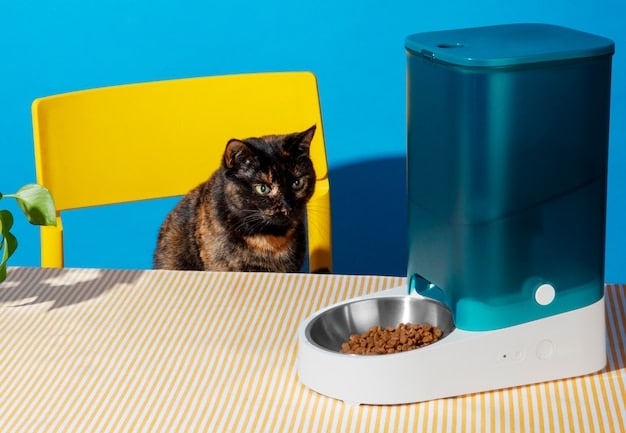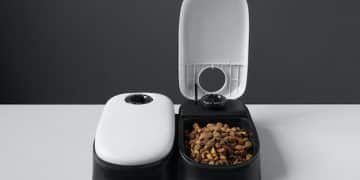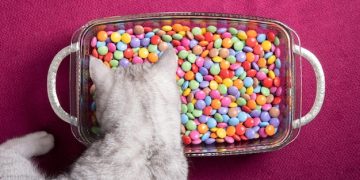Smart Pet Feeders in 2025: Are They Worth the Hype?

Smart pet feeders have become increasingly popular, promising convenience and better pet care, but this review explores their functionality, benefits, and potential drawbacks, questioning if they truly live up to the expectations for pet owners in 2025.
Are you considering a smart pet feeder for your furry friend? The market is buzzing with these devices, promising to revolutionize pet care. This article dives deep into whether the hype is real regarding smart pet feeders in 2025, examining their features, benefits, and potential drawbacks to help you make an informed decision.
The Rise of Smart Pet Tech
The world of pet care is rapidly evolving, with technology playing an increasingly prominent role. From GPS trackers to interactive toys, pet owners now have access to a wide array of gadgets designed to enhance their companions’ lives. Among these innovations, smart pet feeders have emerged as a popular choice, but what’s driving this trend?
Several factors contribute to the growing interest in smart pet tech. Busy lifestyles often leave pet owners feeling guilty about leaving their animals alone for extended periods. Smart feeders offer a solution by automating meal times, allowing owners to maintain consistent feeding schedules even when they’re away from home. Additionally, the increasing awareness of pet health and nutrition has led many owners to seek precise portion control, which these devices can provide.
Key Features of Smart Pet Feeders
Smart pet feeders come equipped with a range of features designed to make pet feeding more convenient and controlled.
- Automated Dispensing: Scheduled feedings ensure your pet eats on time, every time.
- Portion Control: Precise measurements prevent overfeeding and help manage your pet’s weight.
- Remote Monitoring: Many models include cameras and microphones, allowing you to check in on your pet during meal times.
- App Integration: Control and adjust feeding schedules, portion sizes, and receive notifications via your smartphone.
These features collectively aim to give pet owners peace of mind and improve the overall feeding experience for their pets.
In conclusion, the rise of smart pet tech, particularly smart pet feeders, reflects a larger trend towards using technology to improve pet care and address the challenges of modern lifestyles. As technology continues to advance, we can expect to see even more innovative solutions emerge in the pet care market.

Benefits of Using Smart Pet Feeders
Beyond the convenience factor, smart pet feeders offer several tangible benefits for both pets and their owners. These advantages range from improved health management to enhanced peace of mind for busy pet parents.
One of the primary benefits is the ability to manage your pet’s diet with greater precision. This is particularly important for pets with specific dietary needs or health conditions. With programmable portion control, owners can ensure their pets receive the correct amount of food at each meal, preventing overeating or underfeeding.
Health and Wellbeing
Smart pet feeders can play a crucial role in maintaining your pet’s health and wellbeing.
- Weight Management: Controlled portions help prevent obesity, a common health issue in pets.
- Consistent Feeding Schedule: Regular meal times can improve digestion and overall health.
- Medication Dispensing: Some feeders can be programmed to dispense medication along with meals, ensuring your pet receives necessary treatments on time.
By automating and controlling the feeding process, smart feeders contribute to a healthier lifestyle for your pet.
For busy pet owners, smart feeders offer an invaluable sense of security. Knowing that your pet is being fed on a regular schedule, even when you’re not home, can alleviate anxiety and guilt. Many feeders also include features like cameras and microphones, allowing you to check in on your pet remotely and ensure they’re doing well. In summary, the benefits of using smart pet feeders extend beyond mere convenience, positively impacting both the health and peace of mind of pet owners. From precise dietary control to remote monitoring, these devices offer a comprehensive solution for modern pet care.
Potential Drawbacks and Concerns
While smart pet feeders offer numerous benefits, it’s essential to consider potential drawbacks and concerns before investing in one. These issues can range from technical glitches to behavioral challenges, and understanding them is crucial for making an informed decision.
One common concern is the reliance on technology. Smart feeders depend on a stable internet connection and consistent power supply to function properly. If either of these is disrupted, the feeder may fail to dispense food, potentially leaving your pet hungry. Additionally, some feeders can be complex to set up and program, requiring a certain level of technical expertise.
Common Issues
Here are some of the most common issues reported by smart pet feeder users:
- Connectivity Problems: Frequent disconnections from Wi-Fi can disrupt scheduled feedings.
- Mechanical Failures: Dispensing mechanisms can malfunction, leading to incorrect portion sizes or no food being dispensed at all.
- App Glitches: Software bugs in the feeder’s app can cause scheduling errors or other operational issues.
Addressing these potential issues proactively can help minimize disruptions and ensure your pet’s feeding schedule remains consistent.

In addition to technical concerns, behavioral challenges can also arise. Some pets may become overly reliant on the feeder, losing interest in eating from a traditional bowl or developing anxiety when the feeder malfunctions. It’s important to monitor your pet’s behavior and adjust their feeding routine as needed to avoid these issues. In conclusion, while smart pet feeders offer convenience and control, potential drawbacks such as technical glitches and behavioral challenges should be carefully considered. By understanding these concerns and taking proactive steps to address them, pet owners can make the most of these devices while minimizing potential problems.
Evaluating Different Smart Pet Feeder Models
The market for smart pet feeders is diverse, with numerous models offering a wide range of features and price points. Choosing the right feeder for your pet depends on several factors, including your pet’s size, dietary needs, and your budget. Researching and comparing different models is essential to ensure you select a feeder that meets your specific requirements.
When evaluating different smart pet feeder models, consider the following factors:
Key Considerations
Consider the following technical and practical aspects when choosing a smart pet feeder:
- Capacity: Ensure the feeder can hold enough food to last for the desired period, especially if you plan to be away for several days.
- Dispensing Accuracy: Look for models that offer precise portion control to maintain consistent feeding schedules.
- Durability: Opt for feeders made from high-quality materials that can withstand daily use and potential mishaps.
- Ease of Cleaning: Choose models with removable and dishwasher-safe components for easy maintenance.
By carefully considering these factors, you can narrow down your choices and select a feeder that provides reliable and convenient feeding for your pet. Additionally, reading reviews from other pet owners can provide valuable insights into the real-world performance of different models.
Beyond the basic features, some smart pet feeders offer advanced capabilities such as built-in cameras, voice recording, and activity tracking. While these features can enhance the overall experience, they also come at a higher price point. Determine which features are most important to you and balance them against your budget when making your decision. In conclusion, evaluating different smart pet feeder models requires careful consideration of your pet’s needs, your budget, and the features that are most important to you. By researching and comparing different options, you can find a feeder that provides reliable, convenient, and personalized feeding for your furry friend.
Setting Up and Maintaining Your Smart Pet Feeder
Once you’ve chosen the perfect smart pet feeder, the next step is to set it up correctly and maintain it properly. Proper setup ensures your feeder functions smoothly and provides consistent feeding for your pet. Regular maintenance, on the other hand, helps prolong the lifespan of your feeder and prevent potential issues.
Setting up your smart pet feeder typically involves connecting it to your home’s Wi-Fi network and programming the feeding schedule through a mobile app. Follow the manufacturer’s instructions carefully, ensuring you understand each step of the process. If you encounter any difficulties, consult the feeder’s user manual or contact customer support for assistance.
Tips for Setup and Maintenance
For a smart setup and easy maintenance, keep the following in mind:
- Stable Wi-Fi Connection: Place the feeder in an area with a strong and stable Wi-Fi signal to prevent disconnections.
- Regular Cleaning: Clean the food container and dispensing mechanism regularly to prevent build-up and ensure accurate portion control.
- Backup Power: Consider using a battery backup to keep the feeder running during power outages.
These maintenance tasks are important to ensure reliability.
In addition to regular cleaning, it’s also important to monitor your pet’s feeding behavior and adjust the feeder’s settings as needed. For example, if you notice your pet is not eating all of the food dispensed, you may need to reduce the portion size or adjust the feeding schedule. Similarly, if your pet seems hungry between meals, you may need to increase the portion size or add an additional feeding time. In conclusion, setting up and maintaining your smart pet feeder properly is essential for ensuring its smooth operation and longevity. By following the manufacturer’s instructions, performing regular maintenance, and monitoring your pet’s feeding behavior, you can provide consistent and reliable feeding for your furry friend.
The Future of Smart Pet Feeding Technology
The world of smart pet feeders is continually evolving, with new innovations and advancements on the horizon. As technology progresses, we can expect to see even more sophisticated and user-friendly feeders that offer enhanced features and greater control over pet feeding.
One promising area of development is the integration of artificial intelligence (AI) and machine learning (ML) into smart pet feeders. AI-powered feeders could potentially learn your pet’s feeding habits and automatically adjust the feeding schedule and portion sizes based on their individual needs. They could also detect signs of illness or discomfort and alert you to potential health problems.
Emerging Technologies
What are the future technological possibilities in the development of smart pet feed technology?
- AI-Powered Customization: Automatic adjustments to portion sizes and feeding schedules based on your pet’s individual needs.
- Health Monitoring: Integration with wearable devices to track your pet’s activity levels and adjust feeding accordingly.
- Improved Connectivity: More reliable and secure connections to prevent feeding disruptions.
These new improvements can increase the functionality and peace of mind regarding smart pet feed technology.
Another area of focus is the development of more sustainable and eco-friendly feeders. As environmental awareness grows, pet owners are increasingly seeking products that minimize their carbon footprint. Future smart pet feeders may be made from recycled materials and designed to reduce food waste. In conclusion, the future of smart pet feeding technology is bright, with numerous innovations and advancements on the horizon. From AI-powered customization to eco-friendly designs, these developments promise to make pet feeding even more convenient, personalized, and sustainable.
| Key Point | Brief Description |
|---|---|
| ⏰ Scheduled Feeding | Automated dispensing ensures consistent meal times. |
| ⚖️ Portion Control | Precise measurements prevent overfeeding and aid weight management. |
| ⚠️ Potential Drawbacks | Reliance on tech, connectivity issues, and possible mechanical failures. |
| 📱 App-Based Control | Remote scheduling and monitoring via smartphone apps. |
Frequently Asked Questions
▼
Smart pet feeders can be a worthwhile investment for busy pet owners, those needing precise portion control, or those seeking to maintain consistent feeding schedules. Evaluate your specific needs and budget to determine if a smart feeder is right for you.
▼
Consider factors such as your pet’s size, dietary needs, and your budget. Look for models with reliable dispensing accuracy, durable construction, and user-friendly app integration. Read customer reviews for real-world performance insights.
▼
Drawbacks include reliance on technology, potential connectivity issues, mechanical failures, and possible app glitches. Monitor your pet’s behavior for signs of over-reliance or anxiety related to the feeder’s operation.
▼
Yes, smart feeders can be very helpful for weight management. They provide precise portion control, which is essential for preventing overeating and maintaining a healthy weight. The scheduled feeding times also promote better digestion.
▼
Regular cleaning is crucial. Clean the food container and dispensing mechanism at least once a week to prevent food build-up and ensure accurate dispensing. Some models have dishwasher-safe parts for easier maintenance.
Conclusion
In conclusion, smart pet feeders offer numerous benefits for pet owners in 2025, including convenience, precise portion control, and improved health management. While potential drawbacks such as technical glitches and behavioral challenges should be considered, the advancements in smart pet feeding technology make these devices increasingly valuable tools for modern pet care.





